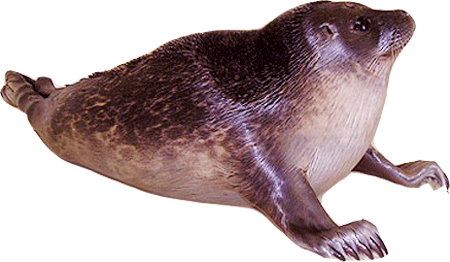Ringed Seal

Scientific Classification
- Kingdom: Animalia
- Phylum: Chordata
- Class: Mammalia
- Order: Carnivora
- Family: Phocidae
- Genus: Phoca
- Species: hispida
Description
Ringed seals are part of the "true seal" family Phocidae. The ringed seal is the smallest and most common seal in the Arctic. They have a small head, short cat-like snout, and a plump body. Their coat is dark with silver rings on their back and sides with a silver belly. Their small foreflippers have claws more than 1 inch (2.5 cm) thick that are used to maintain breathing holes through 6.5 ft (2 m) thick ice.
Size
They grow to average lengths of 5 ft (1.5 m) with weights ranging from 110-150 lbs (50-70 kg). Ringed seals live about 25 to 30 years.
Diet
Ringed seals eat a wide variety of small prey that consists of 72 species of fish and invertebrates.
Habitat
Ringed seals reside in arctic waters and are commonly associated with ice floes and pack ice.
Distribution
The ringed seal is found in the Northern Hemisphere with a circumpolar distribution ranging from 35N to the North Pole. There is only one recognized stock of ringed seals in U.S. waters: the Alaska stock.
Population Trends
The estimated population size for the Alaska stock of ringed seals is 249,000 animals. Currently, the population trend for this stock is unknown.
 Deep Sea Crabs
Deep Sea Crabs